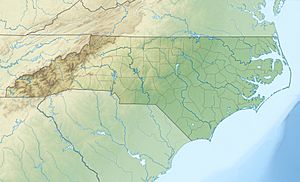Alligator River (North Carolina) facts for kids
Quick facts for kids Alligator River |
|
|---|---|
|
Location of Alligator River mouth
|
|
| Other name(s) | Tributary to Albemarle Sound |
| Country | United States |
| State | North Carolina |
| Counties | Dare Hyde Tyrell |
| Physical characteristics | |
| Main source | divide between Pungo River, Lake Mattamuskeet and Alligator River about 3 miles NW of Fairfield, North Carolina 2 ft (0.61 m) 35°33′59″N 075°58′54″W / 35.56639°N 75.98167°W |
| River mouth | Albemarle Sound East Lake, North Carolina 0 ft (0 m) 35°58′02″N 075°58′54″W / 35.96722°N 75.98167°W |
| Length | 47.37 mi (76.23 km) |
| Basin features | |
| Progression | North |
| River system | Albemarle Sound |
| Basin size | 571.24 square miles (1,479.5 km2) |
| Tributaries |
|
The Alligator River is a small river located in eastern North Carolina. It helps separate Dare County from Tyrrell County. This river flows into the Albemarle Sound. A special canal, about 21 miles long, connects the Alligator River to the Pungo River to its west. You can cross the Alligator River using the Lindsey C. Warren Bridge, which is part of U.S. Route 64.
Contents
Alligator River: A Home for Wildlife
The Alligator River is a very important place for nature. It is protected as part of the Alligator River National Wildlife Refuge. This refuge is a special area where animals and plants can live safely.
What Kinds of Habitats Are There?
The land around the Alligator River National Wildlife Refuge has many different types of natural areas, called habitats. These include:
- Pocosin: These are wetlands with sandy, acidic soil. They have dense shrubs and trees.
- Bogs: These are spongy wetlands that are very wet and often have peat.
- Marshes: These are wetlands with grassy plants. Some marshes here have fresh water, while others have brackish water, which is a mix of fresh and salty water.
- Swamps: These are wetlands with trees. You can find hardwood swamps and Atlantic white cypress swamps.
Plants of the Alligator River
Many interesting plants grow in these habitats. Some of them are:
- Pitcher plants and sun dews, which are unique carnivorous plants.
- Low bush cranberries.
- Redbay trees.
- Atlantic white cypress trees.
- Pond pine trees.
- American sweetgum trees.
- Red maple trees.
There are also many different types of herbaceous plants (plants with soft stems) and shrubs that are common along the East Coast.
Amazing Animals of the Refuge
The Alligator River National Wildlife Refuge is famous for its wildlife. It's one of the best places on the Eastern Seaboard to see American black bears.
You can also find many other animals here, such as:
- Different kinds of ducks, geese, and swans.
- Wading birds and shorebirds.
- The American woodcock.
- Raptors, like hawks and eagles.
- Of course, alligators!
- White-tailed deer.
- Raccoons.
- Cottontail rabbits.
- Bobwhite quail.
- Northern river otters.
- Red wolves, which are very rare.
- Red-cockaded woodpeckers.
- Many different kinds of birds that migrate, called neotropical migrants.


